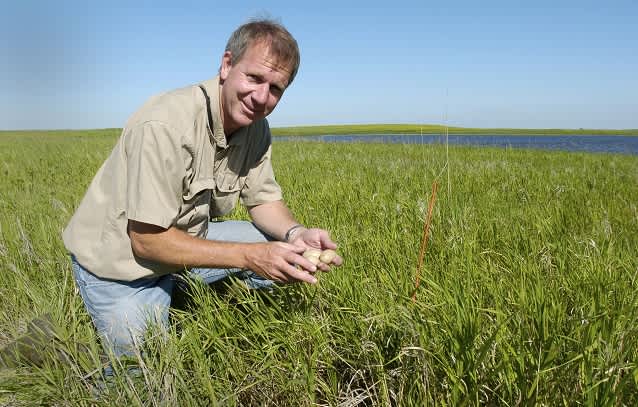Professor: Intensive Waterfowl Management may be Required Down the Road
OutdoorHub 11.14.11

Bismarck, N.D.—Dr. Frank Rohwer has a warning for duck hunters: The conditions that produced the remarkable fall flights of recent years won’t last forever, and that means fewer ducks down the road.
“Duck production is the furthest thing from hunters’ minds right now,” admits Rohwer, a professor at Louisiana State University’s School of Renewable Natural Resources. “Duck populations are high and hunters are laughing. But if we lose the Conservation Reserve Program’s nesting cover and the prairie breeding grounds go dry, duck numbers will plunge, and hunter and managers alike will be asking what we can do for ducks.”
Fortunately Rohwer, who doubles as director of Delta Waterfowl’s scientific research program, believes he has the answer: intensive management techniques like predator management, artificial nesting structures and conservation programs that protect small wetlands.
In recent years, waterfowl scientists have been forced to acknowledge a dramatic shift in duck distribution from the Canadian prairies to the U.S. side of the breeding grounds, a trend that continued the last two breeding seasons.
The shift occurred because CRP provided 5 million acres of lush nesting cover and productive wetlands in North and South Dakota, while in Canada wetland losses are ongoing, and large, undisturbed blocks of grass nesting cover are scarce.
Delta research has found hatch rates in prairie Canada commonly below five percent. Key production areas such as Minnedosa, Manitoba are consistently less than three percent, well below the necessary 15 percent needed to maintain populations.
As a result, the U.S. has been attracting mallards, pintails, blue-winged teal, gadwalls and shovelers at a rate far above historical levels, while prairie Canada has struggled to keep pace with its long-term average for most of the upland-nesting species.
Rohwer, himself an avid waterfowl hunter, doesn’t hide his concern about what’s coming as CRP acres are put into agricultural production. At the current rate of CRP loss, North and South Dakota will slip to around 1.5 million acres by 2013.
“We can’t give up on CRP,” he says. “Hunters must press Congress to maintain a viable program. It is simply critical to waterfowl, pheasants, and lots of other wildlife. But looking into my crystal ball, with commodity prices as high as they are and the current debates over federal spending, I don’t know if CRP will continue to have the impact it has had over the last two decades.”
Lacking large blocks of undisturbed CRP cover, intensive management, like predator control, might be the most important tool in the waterfowl manager’s kit. Delta began managing predators in the 1994 breeding season, and it quickly proved to be an effective technique for boosting sagging nest success. But as the duck population expanded, thanks to CRP and unusually wet conditions, subsequent studies showed that ducks didn’t need any help in those areas. That is why Delta switched its predator management research to areas of low grass.

“Ducks have done so well in areas with CRP that nesting hens simply don’t need a helping hand,” says Rohwer, “but ducks are struggling in many areas and in a couple years, we may not have any choice–low grass sites will be all that’s left.”
In 2009 and 2010 Delta shifted its efforts in North Dakota to areas that continued to attract high densities of nesting ducks but had relatively little (10 percent or less) grass nesting cover. Research also shifted to prairie Canada, where nest success is consistently low.
The results of those two years were impressive, with 28.3 percent nest success for ducks nesting in trapped areas compared to 6.4 percent for sites that had similar cover but were not trapped.
In 2011, one North Dakota site saw higher nest success on the trapped block: 35.5 percent versus 10.2. The second location, however, showed very different results. The trapped blocks came in with a 47 percent nest success. But the control, or non-trapped site, enjoyed a whopping 64.1 percent success rate.
“It was the most amazing thing I’ve ever seen,” says Rohwer. “That site shows what we’ve known for a decade: that you’ll get incredible variation in nest success from one site to another, and from year to year.
“We know from our trap sites that ducks respond to one another during the breeding season. If there’s a safe piece of ground, you’ll see a buildup of ducks nesting there because they’re keying on the other ducks using that spot.
“This area was two pieces of grass that were totally isolated–nothing but black dirt for miles in every direction. I guess there was no reason for predators to go there, and the buildup of nesting ducks was remarkable.”
Delta also trapped Manitoba the last two years. In Minnedosa, the trapped block enjoyed 49.5 percent nest success to just 2.5 percent on a non-trapped control site in 2010, and 32.7 to 0.5 in 2011.
At the Shoal Lake site, nest success was 37 percent trapped versus 3.6 non-trapped in 2010. In 2011, however, the trapped site was only 6.9 percent compared to 5.2 percent at the control site.
Says Rohwer: “The unprecedented flooding in Manitoba caused havoc with the Shoal Lake site. The trapper couldn’t get around and our students had a hard time nest searching. But that’s why we do the research and that’s why we do this work over many sites for many years, to get a solid answer.”
Delta plans to continue its predator management in 2012 on the same sites. Average nest success over the span of three years of evaluation in North Dakota is 32.6 percent nest success on trapped sites versus 16.7 percent nest success on non-trapped sites. In Manitoba, nest success on predator removal sites has averaged 31.5 percent nest success. The non-trapped sites averaged 3 percent over two years of evaluation.

